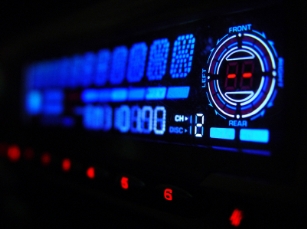Will new car audio technology lead to more distracted drivers?
Nick DiUlio
It wasn’t long ago when listening to music in your car meant one of two things: turning on the radio or popping in a CD or cassette tape. Those days are quickly fading in the rearview mirror as more and more vehicles now come equipped with everything from MP3 input jacks to glossy touchscreen dashboards that are able to deliver hundreds of thousands of internet radio options from around the world.
But with this new burst of technology comes an increased risk of driver distraction, which can have a negative effect on both your safety and your insurance rates.
“We don’t often think about it as a significant distraction when we look down to adjust the radio, but when you’re cruising down the highway at 60 miles an hour, that quick glance is a lot of time,” says Tully Lehman, spokesman for the Insurance Information Network of California.
 Lehman points out that 60 miles per hour is equivalent to 88 feet per second. Taking your eyes off the road for just three seconds means you’ve traveled 264 feet without seeing what’s in front of you.
Lehman points out that 60 miles per hour is equivalent to 88 feet per second. Taking your eyes off the road for just three seconds means you’ve traveled 264 feet without seeing what’s in front of you.
“A lot of things can happen on a 264-foot stretch of highway,” Lehman says.
According to a 2010 survey conducted by Nationwide Insurance, more than 80 percent of polled drivers identified themselves as multitaskers (meaning they frequently engage in other tasks while behind the wheel). The number one culprit: Adjusting audio devices, with 82 percent of respondents saying they frequently engage in this behavior while driving.
New types of audio in cars
At the 2013 Consumer Electronics Show (CES) in January, several automakers unveiled new hi-tech dashboard audio technologies.
For instance, Volvo unveiled a new “infotainment” dashboard that uses cloud server technology to feed apps and other types of digital content directly into the vehicle. Chrysler, meanwhile, introduced its Uconnect Access Via Mobile, a cloud-connected streaming audio feature that delivers content from iHeartRadio, Pandora, Slacker and Aha apps to vehicles that are equipped with the new system.
Audi was another big player in the streaming audio realm at CES. The automaker announced a new infotainment system available for its A3 and A3 Sportback vehicles. It’s a first-of-its-kind central computer located in the glove compartment that not only streams various audio apps and digital content directly to the vehicle, but can also be upgraded with up-to-date computer chips and software as the technology improves (similarly to the way we update software on our home computers).
For more than a year now, Toyota has equipped many of its vehicles with Entune, which lets drivers stream Pandora and iHeartRadio as well as perform tasks like restaurant reservations and traffic and weather updates.
The double-edged sword of added distractions, however, has not been lost on automakers.
“On one hand, (automakers) are trying to add technology to vehicles because consumers want it,” says Doug Newcomb, senior technology editor at the automotive website Edmunds.com. “But they also struggle with the fact that it adds to driver distraction.”
How to fight distracted driving
According to a February study conducted by the Centers for Disease Control and Prevention (CDC), more than nine people are killed each day in crashes caused by distracted driving. According to the Department of Transportation, 2011 saw 3,331 people die in distracted-driving accidents.
And of the nearly 900,000 crashes involving distracted driving reported to police in 2010, 26,000 involved adjusting devices or controls in the car, which include radios, CD or MP3 players and GPS systems.
In order to address this problem, NHTSA recently proposed guidelines that might make onboard devices less distracting to drivers. The guidelines—which car makers are not legally obligated to follow—require all dashboard functions to be possible with one or more two-second glances away from the road. They also include recommendations to:
- Reduce complexity and task length required by the device.
- Limit device operation to one hand only.
- Limit unnecessary visual information in the driver’s field of view.
- Limit the number of manual inputs required for device operation.
Additionally, Carroll Lachnit, features editor for Edmunds.com, says automakers are coming out with increasingly hands-free dashboard control options in order to stem the distractions tide.
“The most popular thing you’ll see these days are steering wheel mounted controls that can cycle through everything from the iPod to the CD player to the Bluetooth,” Lachnit says. “But driver distraction isn’t just about the technology. We need to change our behaviors and how we respond to the technology in the process.”
The insurance impact of distracted driving
Not only is distracted driving extremely dangerous to you, your passengers and others on the road, it could also lead to a world of hurt when it comes to your auto policy.
According to Dan Weedin, a Seattle-based insurance and risk management consultant, if you’re involved in an at-fault accident because you were distracted, it’s just like running a stoplight and hitting someone.
“In the insurance company’s eyes that’s a high degree of negligence and your policy is probably not going to be renewed,” Weedin says.
Weedin points out that several studies have concluded that distracted driving—in all forms—is just as dangerous as driving under the influence. Many insurers will look at a distraction-related accident the same way they would if it was caused by a DUI.
If an insurance company drops your coverage, Weedin says shopping for a new policy will be very challenging. The negligence that caused the accident will stay on your record for three years, during which companies are either going to deny you a policy or charge an expensive high-risk premium.
